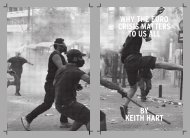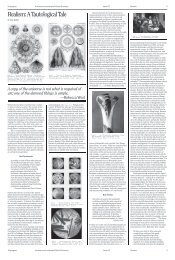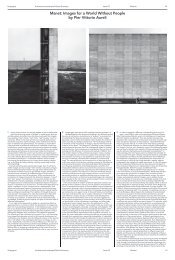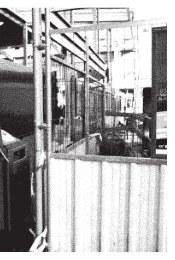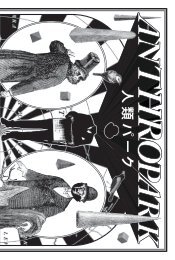Full Issue - Scapegoat
Full Issue - Scapegoat
Full Issue - Scapegoat
Create successful ePaper yourself
Turn your PDF publications into a flip-book with our unique Google optimized e-Paper software.
Extreme<br />
StadtStaat<br />
Stuttgart<br />
– utrecht<br />
Democracy<br />
Management.<br />
By the People.<br />
Stuttgart–Utrecht<br />
Strategic Planners. Strategic Partners.<br />
SOCIOCONNECT<br />
Wir sind verbunden.<br />
1<br />
2<br />
3<br />
eu<br />
abc def<br />
4<br />
5<br />
6<br />
ghi<br />
jkl mno<br />
7<br />
8<br />
9<br />
pqrs<br />
tuv wxyz<br />
*<br />
0<br />
#<br />
+<br />
Coming Democracy<br />
Going beyond place branding, Utrecht and<br />
Stuttgart form a regional Stadtstaat (city-state).<br />
This programmatic reflection on the urban<br />
fabric created by European unification invites<br />
us to interrogate policy decisions to weather<br />
the economic downturn while enhancing networking<br />
capacities. Stadtstaat is managed via<br />
an information architecture called ‘Trust.’ A<br />
socio-political Facebook, Trust is a networking<br />
platform that governs through public<br />
participation—an ‘open system’ presenting a<br />
shift from central decisionmaking to managing<br />
social dynamics. 1 The progress and partial victory<br />
of network architecture over built form is<br />
one of the core attributes of Stadtstaat's new<br />
equilibrium. The transformation of urban space<br />
into an arena for networked sociability brings<br />
about a new understanding of what makes a<br />
place public. Not a public guaranteed by policing,<br />
but one negotiated by groups within the<br />
territory. Endure the politically correct jargon<br />
in the city-state of the oxymoron: ‘Managing<br />
diversity.’<br />
The apparent lack of order seems to be the<br />
new order.<br />
Metahaven is a studio for research and design<br />
based in Amsterdam, consisting of graphic<br />
designers Daniël van der Velden and Vinca<br />
Kruk, and formerly, architectural designer Gon<br />
Zifroni. Since 2004, Metahaven has developed<br />
projects that investigate the political potentials<br />
of graphic design and as a tool for<br />
research. Metahaven’s previous projects include<br />
the “Sealand Identity Project,” a research into<br />
a national brand for a micronation and tax<br />
haven, and “History vs. Future” which investigates<br />
the People’s House in Bucharest and its<br />
double existence as a post-communist icon and<br />
contemporary art museum.<br />
www.metahaven.net<br />
Notes<br />
1. See Colleen Graffy, “The Rise of Public<br />
Diplomacy 2.0,” in The Journal of International<br />
Security Affairs 17, Fall 2009, 48.<br />
TRUST<br />
Soziale Netzwerke<br />
gegen Terrorismus.<br />
Waiting<br />
Friend,<br />
Are we the Hinterland? Stuttgart and Utrecht,<br />
twinned by their new operative unity, share a<br />
particular type of position both on the European<br />
map and in geopolitical space-time.<br />
Softened by the welfare state and regional<br />
planning (and possibly by a Western European<br />
wealth buffer), the impact of global development<br />
reaches our cities in the form of a suspicious<br />
absence of events.<br />
An ‘analysis.’<br />
Neither Stuttgart nor Utrecht is metropolitan.<br />
But there are agreeable living conditions,<br />
knowledge capital, proximity to airports, etc.<br />
Neither of the cities experiences the staggering<br />
changes encountered in the global East<br />
and South. In a combination of melancholia<br />
and relief, it seems as if both cities—united<br />
by a strange managerial invention, called<br />
Stadtstaat—are merely waiting for the storms<br />
to impact. Or, perhaps even more plausibly,<br />
Stadtstaat is subject to a low-intensity transformation<br />
revealed through an increasingly peculiar<br />
urban and social vernacular, sometimes<br />
called a ‘Pizza-Staat’ or ‘Gadgetopia.’<br />
If I sound like an architect, that is no coincidence.<br />
I am one. And all I have produced are<br />
plans and studies. Not one of them was selected<br />
for realization. Every project we pitched<br />
was forever postponed. Initially, responses<br />
were always positive, even affirmative. In the<br />
lingo of the creative industries, ‘the client<br />
loved it.’ Then things stalled. A manager took<br />
the stage. Invariably he would begin by stating<br />
his diagnosis that we architects are defining<br />
architecture too narrowly and too formally.<br />
Architects, he argued, misuse the brief to avoid<br />
real needs and erect monumental structures—<br />
vain and unsustainable. Instead, he persisted,<br />
architecture is everywhere, and ‘produced by<br />
real people.’ There are many other and more<br />
relevant architectures, like ‘social architecture,’<br />
‘network architecture,’ ‘choice architecture,’<br />
and ‘trust architecture.’ By the time he<br />
was done explaining all the different architectures,<br />
the client no longer believed in realizing<br />
a building, but in fostering ‘change.’ Systems<br />
managers and web designers moved in and<br />
they talked about haptics, intuition, aggregators,<br />
and heat maps. This is the new Esperanto<br />
of the global Hinterland.<br />
So what should I do? Burn my architecture<br />
degree and move to the Black Forest?<br />
—Friend<br />
Renaming Things<br />
Friend,<br />
I will bring this letter to Utrecht myself to protect<br />
its confidentiality and so that you see it in<br />
time. Early one Sunday morning, you will hear<br />
the envelope touch the floor in the hallway. As<br />
you open it, I will have disappeared already.<br />
The journey leads through the Stadtstaat Interurban<br />
Corridor, the Axis. That name sounds<br />
grandiose, but ‘Axis’ is just a new name for an<br />
old highway.<br />
It occurs to me that our Stadtstaat has<br />
taken the task of renaming things very seriously.<br />
They said that fusing the two cities would<br />
generate ‘synergy,’ ‘high quality government.’<br />
‘Extreme democracy.’<br />
Regionalists claimed that the identity of the<br />
smaller city, Utrecht, would be swallowed by<br />
the larger one, Stuttgart.<br />
It turned out there wasn’t any grand sense<br />
of identity in need of preservation. What we<br />
share are standards, routines, and meeting<br />
places. The housing estates, the franchise<br />
stores, the rainy skies, the infrastructural<br />
projects (forever stalled), the business parks,<br />
the kebab restaurants, the night shops, and the<br />
internet cafes. What we share is the cracked<br />
and imperfect world.<br />
First there were the mission statements<br />
about the future of civil society—and how<br />
Stadtstaat would become the testing ground<br />
for a unique experiment. Primitive man, politicians<br />
argued, needed no policing because of<br />
the natural bonds that held society together.<br />
Primitive man lived without social welfare<br />
because communities managed their own<br />
survival.<br />
The future of this revived heritage would<br />
be digital. We were given ‘Trust,’ the informational<br />
backbone of Stadtstaat. An electronic<br />
network with its own embedded social contract,<br />
taking away the last barriers between<br />
politics and daily life.<br />
‘Trust’ rightly assumed that social networking<br />
and surveillance create the same paradigm<br />
from different paths. If you invite an entire<br />
society to link-up, common values self-generate<br />
while discouraging isolationism. Citizens<br />
are kept in check by thousands of their best<br />
friends. Stadtstaat, in a stroke of genius, has<br />
sold our mirror image back to us.<br />
—Friend<br />
Project<br />
Stadtstaat<br />
25



